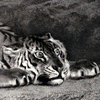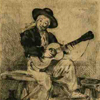Manet used these figures by disassociating them with the previous subjects in order to be able to emulate freely by moving and manipulating these figures in a new way. He used the figure as he would use an apple or a knife in composing a still life. These paintings and engravings are only an arrangement of signs and symbols and which meaning is displayed on within the associations to be made with each other and their surroundings. In his etching of Boy Carrying a Tray (figure 3) he again uses the live model of Leon which adds a layer of authenticity to the etching because on his own in the portable and consumable medium he is recognizable and relevant to the contemporary viewer. The boy, void of anything that recalls an ancient precedent, other than basic body form, he serves as a true relatable image of a modern boy.
Manet uses this boy again in a painting entitled The Spanish Cavaliers (figure 4) in which Manet places the boy in a seventeenth century Spanish setting. Manet shows that you shouldn’t get lost in the fantasy of the picture plane. That these figures are representative only of painted or etched atmospheres they inhabit. It is possible to repeat forms because they can be injected with new meaning as long as they are presented in a way that would be authentic for its particular atmosphere. When the figure is shown alone in an etching he is just a contemporary boy, but when transplanted to another time and place he has a new meaning.
By disengaging these figures from original subject matter he is able to continue the tradition of emulation and repetition in a way that makes it original and relevant for the modern audience. Through prints he places the viewer in the position to engage these figures on a scale that is more personable and relatable in their journey to discover the people and forms that make up the modern world. He portrays these as images that represent the modern world not as models for how you should live in it. He is showing contemporary life by representing how different members participate within it. He repeats images in his own worlds in order to show the flexibility in which these forms can be used once they are stripped away from the stagnant ideologies of the past.
Manet’s version of emulation and repetition is still something that we see in our contemporary society. Music is an area in which songs of the past are reworked and redressed to be used again in a new musical form that will have a social and political meaning for a new audience. When a rap song samples Classical music or Motown the meanings that are associated with those original pieces are lost and when the audience hears them, and even if they recognize it as something old but the way it’s presented to them provides new feelings, meanings and associations. Manet understands that it is possible to repeat forms because even if you understand that it came from somewhere else it is still possible for them to be used in a way that makes them creative, original and relevant for a contemporary audience.
















